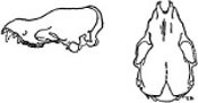Featured Books

The Teeth of the Tiger
lid black; /* a thin black line border.. */ padding: 6px; /* ..spaced a bit out from the gr...
Read More
A New Pocket Gopher (Genus Thomomys) From Wyoming and Colorado
pe.—Male, adult, skull and skin, no. 25628 Mus. Nat. Hist. Univ. Kansas;from 8 mi. N and 19-½ mi....
Read More
On Snake-Poison: Its Action and Its Antidote
f science, and at the same time within the graspof the intelligent, moderately educated layman. When...
Read More
On the Origin and Metamorphoses of Insects
74.New Edition 1890.viiPREFACE.For some years, much of my leisure time hasbeen devoted to the study ...
Read More
Natural History in Anecdote
ions are morevaluable and fascinating, whether as revelations of the order andhabits of Nature herse...
Read More
The Lively Poll: A Tale of the North Sea
smart “fishing breeze” was blowing. The setting sun sparkled on the wave-crests; thin fleecy clo...
Read More
Mr. Punch at the Play: Humours of Music and the Drama
, crown 8vo. 192 pages fully illustratedLIFE IN LONDONCOUNTRY LIFEIN THE HIGHLANDSSCOTTISH HUMOURIRI...
Read More
The World That Couldn't Be
the newly risen sun was dancing off the bright leavesof the hula-trees, making it appear as if the b...
Read More
Comments on "A New Bat (Myotis) From Mexico" :